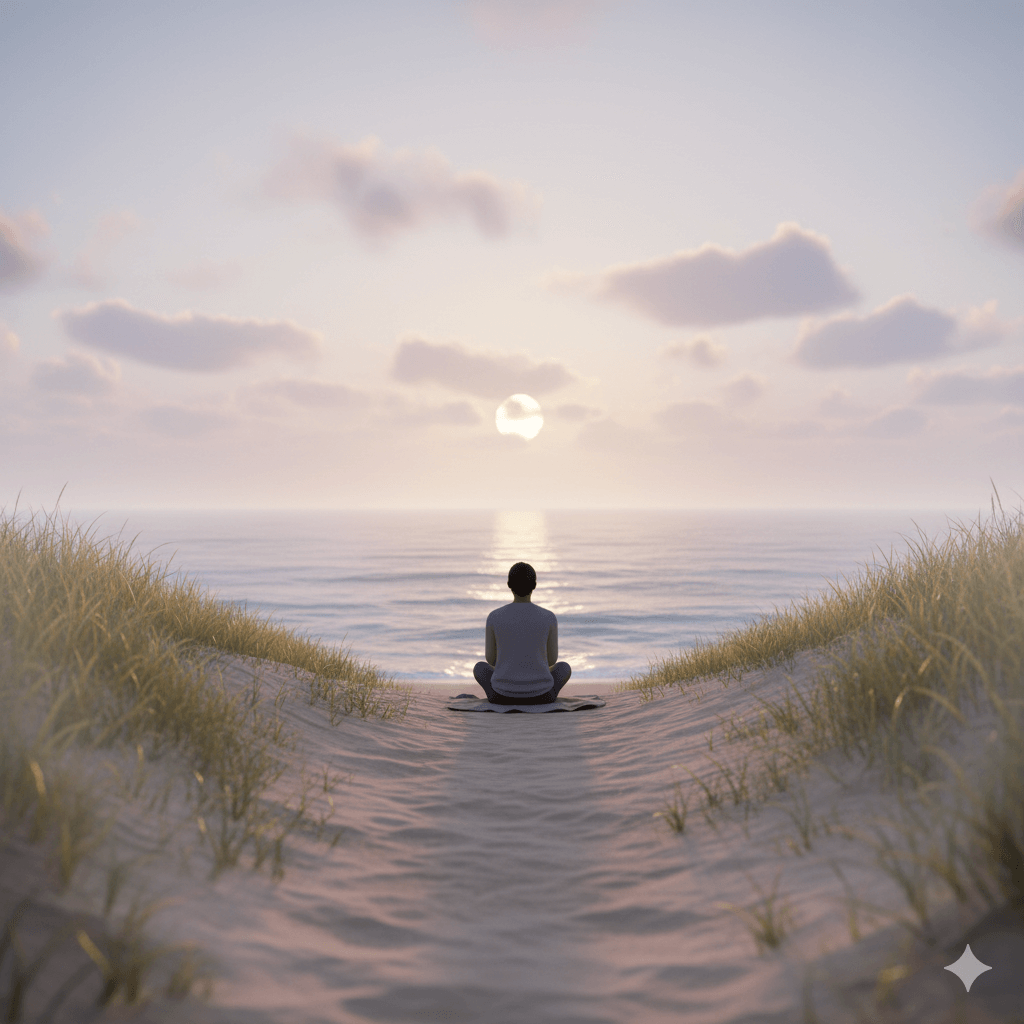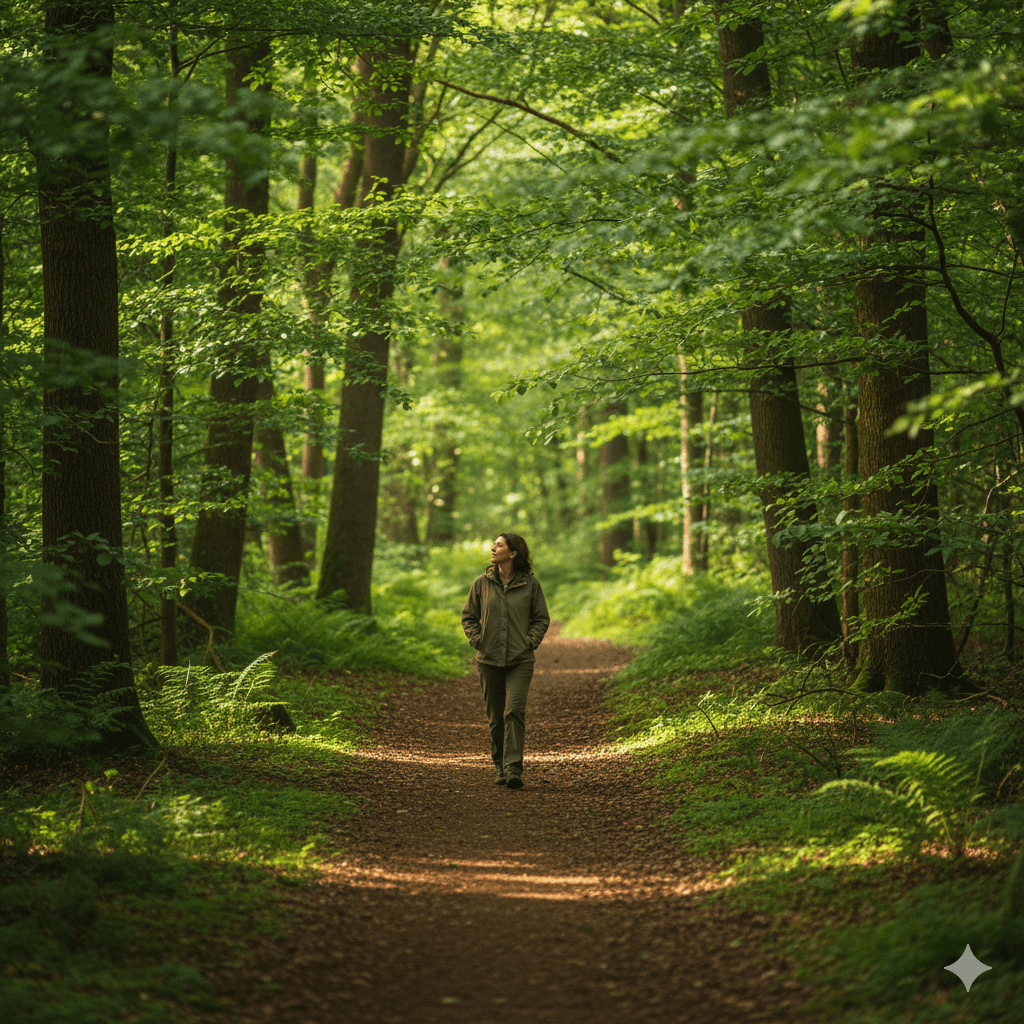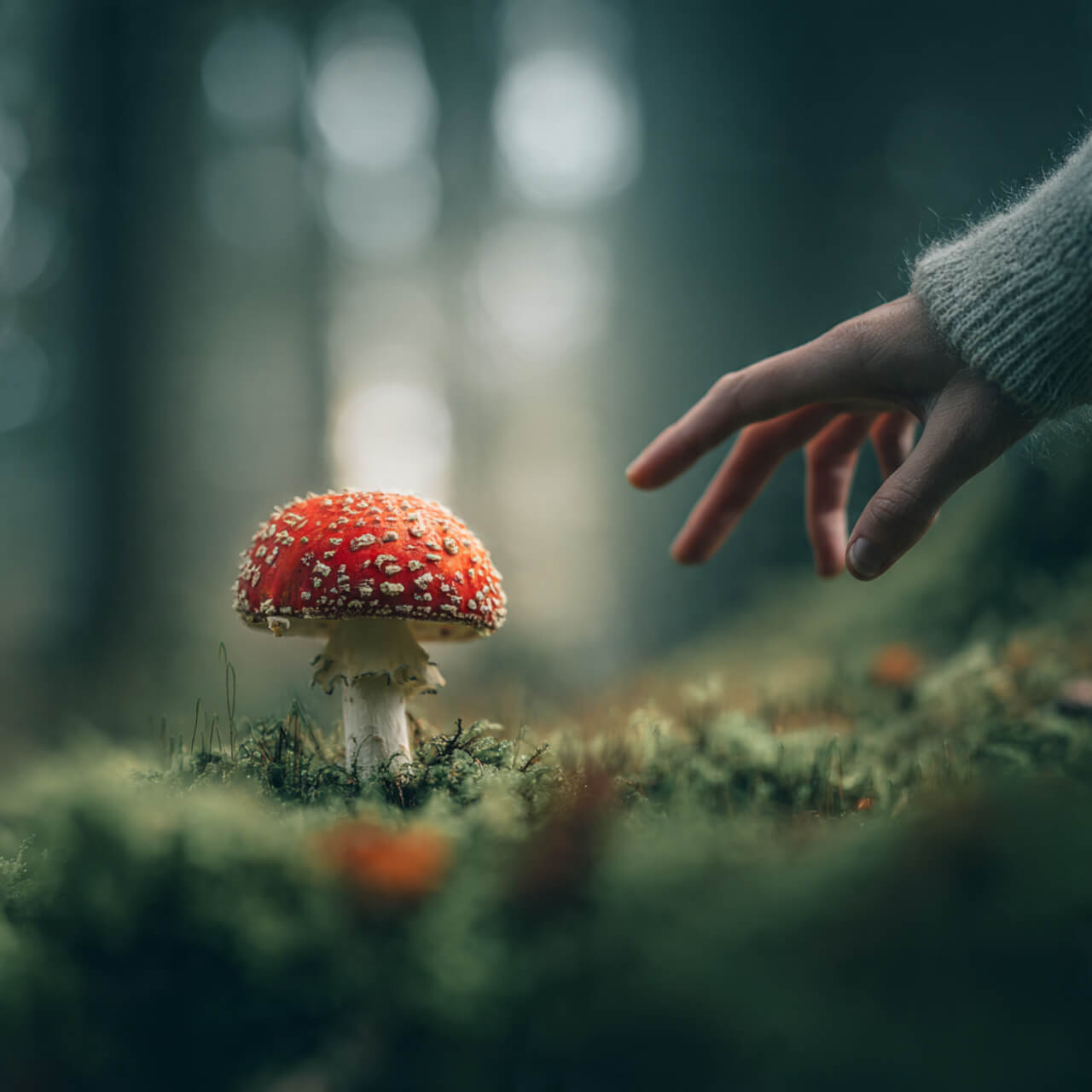Read time: 12 minutes
Quick Summary:
Feeling low as winter sets in? This guide shares calm, practical ways to beat the winter blues in the UK from rain reframes to light therapy and mindful habits that help you live fully through the dark months.
The clocks have gone back. It’s dark before 5 pm. You check the weather forecast and see rain, rain, and more rain stretching out for the foreseeable future.
And you feel it starting that familiar dread that settles in around October and doesn’t lift until March. The winter blues UK residents know all too well. Four or five months of grey skies, endless drizzle, and darkness that makes getting out of bed feel like a like a mountain to climb.
If you live in the UK, you know this feeling intimately. And if you’re anything like most people, you’re probably thinking: “I just need to survive until spring.”
But here’s the problem with that approach.
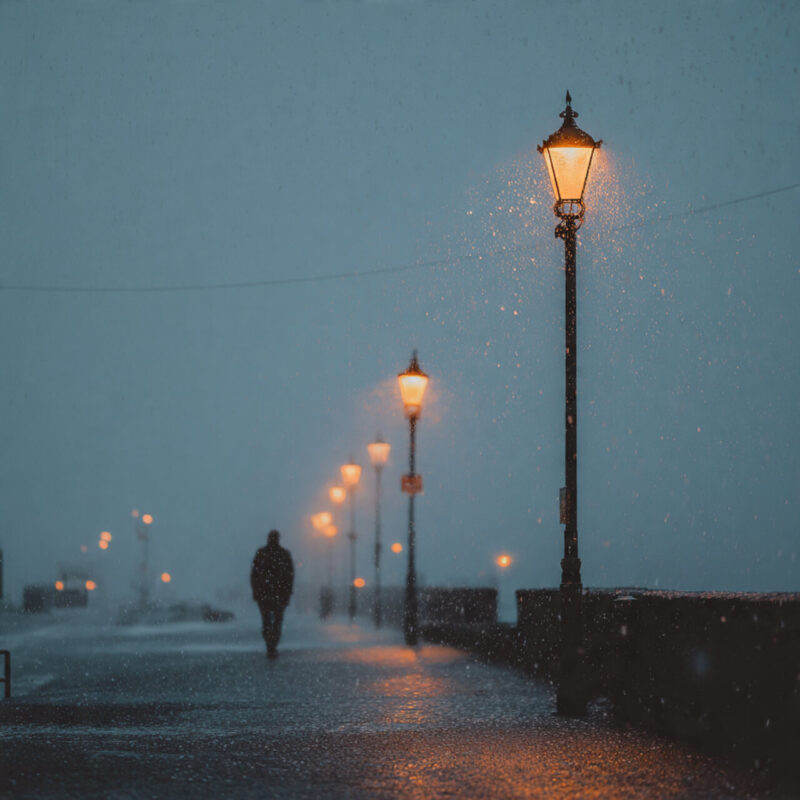
- You're Spending Five Months of Every Year Waiting for Life to Start
- The Mindset Shift That Beats Winter Blues UK
- What Does a Realistic Gratitude Practice for Winter Blues Look Like?
- Living in the Life You Actually Have
- Everyday Mastery Steps You Can Take Now
- 3 Actions You Can Take Today
- Frequently Asked Questions About Winter Blues
You’re Spending Five Months of Every Year Waiting for Life to Start
Think about it. If you’re in “survival mode” from October to March, that’s nearly half your year spent resisting, enduring, pushing through. Half your life waiting for conditions to be perfect before you can actually enjoy being alive.
The rain isn’t going anywhere. Neither is the darkness. This is Britain and if you’re waiting for reliable sunshine, you’ll spend most of your life waiting.
And for many of us, it gets worse than just mild annoyance. Seasonal Affective Disorder (SAD) affects around 1 in 3 people in the UK to some degree. The lack of daylight genuinely impacts your mood, energy, and mental health. This isn’t just about “cheering up”—it’s a real physiological challenge that requires proper coping strategies.
So what’s the alternative? How do you actually beat winter blues without just white-knuckling through until spring?
6 Practical Ways to Beat Winter Blues in the UK:
- Walk in the rain intentionally
- Maximize natural daylight exposure
- Join one seasonal community activity
- Practice realistic gratitude (3-step method)
- **Know when to seek professional support
- Consider getting a SAD lamp for daily light exposure**
Disclaimer: I’m a coach, not a clinician. What I share comes from real practice and personal growth, not therapy. If you’re finding things hard, it’s okay to get professional support — it makes a difference.
The Mindset Shift That Beats Winter Blues UK
What if the goal isn’t to tolerate winter, but to find a way to live fully during it?
I know that might sound like toxic positivity nonsense, especially if you’re struggling. But stay with me this isn’t about pretending the darkness and rain don’t affect you. It’s about something more practical.
It’s about stopping the fight against reality and redirecting that energy somewhere useful. This is the foundation of effectively coping with winter blues UK residents face and managing seasonal affective disorder without burning yourself out in the process.
Here’s what I mean.
The Rain Reframe
You’re going to encounter rain. Frequently. That’s a fact of living here that no amount of complaining will change.
So you have two choices:
- Spend enormous energy resisting it, complaining about it, letting it ruin your plans and your mood
- Accept it’s happening and adjust your response
I used to firmly be in camp one. I hated the rain. Every drop felt like a personal inconvenience. I’d check the weather obsessively, rearranging plans, feeling frustrated and trapped.
Then I tried something different: I started walking in the rain. Intentionally.
Not dashing between doorways with an umbrella, head down, miserable. Actually walking. Proper rain jacket, good boots, no agenda except being outside.
And here’s what I discovered: the world doesn’t stop when it rains.
The parks are still beautiful sometimes even more so. The air smells incredible. The streets have their own quiet rhythm. I’d been missing all of it because I was too busy being annoyed that conditions weren’t “perfect.”
If you need a little motivation, check out the benefits of walking — it’s one of the simplest, most underrated ways to lift your mood and get light exposure, even on grey days.
Feeling disconnected or stuck in a mental fog? This calm 5-minute Buddhist practice guide can help you break autopilot and reconnect with daily life — one conscious breath at a time.
Your action step: Next time it rains, commit to one 10-minute walk. Not rushing to get somewhere, just walking. Notice one thing about it—the sound, the smell, how colors look more saturated. You’re not trying to love it, just to notice it without the resistance.
How Do You Cope With Dark Winter Evenings?
The early darkness is harder to reframe, I’ll admit. When you’re leaving work and it’s already pitch black, it feels oppressive. The mornings are brutal. Your body is screaming for more daylight.
This is where you need to be realistic: if you’re struggling with genuine SAD symptoms, please speak to your GP. Light therapy lamps (SAD lamps) can make a real difference. Vitamin D supplementation helps many people through the darker months. Sometimes you need professional support. For more guidance on Seasonal Affective Disorder, visit the NHS Seasonal Affective Disorder page. It explains common symptoms, treatments, and when to seek help in the UK. There’s no gratitude practice that replaces actual treatment for Seasonal Affective Disorder.
But alongside seeking help if you need it, here’s what else is true: darkness makes light more intentional.
Think about it. In summer, light is just… there. Abundant, taken for granted. But in winter? Every string of fairy lights, every candle, every lamp becomes deliberate. A choice to create warmth and brightness when nature isn’t providing it.
This is why Halloween and Christmas exist when they do. They’re not random. These celebrations happen in the darkest part of the year because humans have always known we need light, gathering, and community precisely when conditions are bleakest.
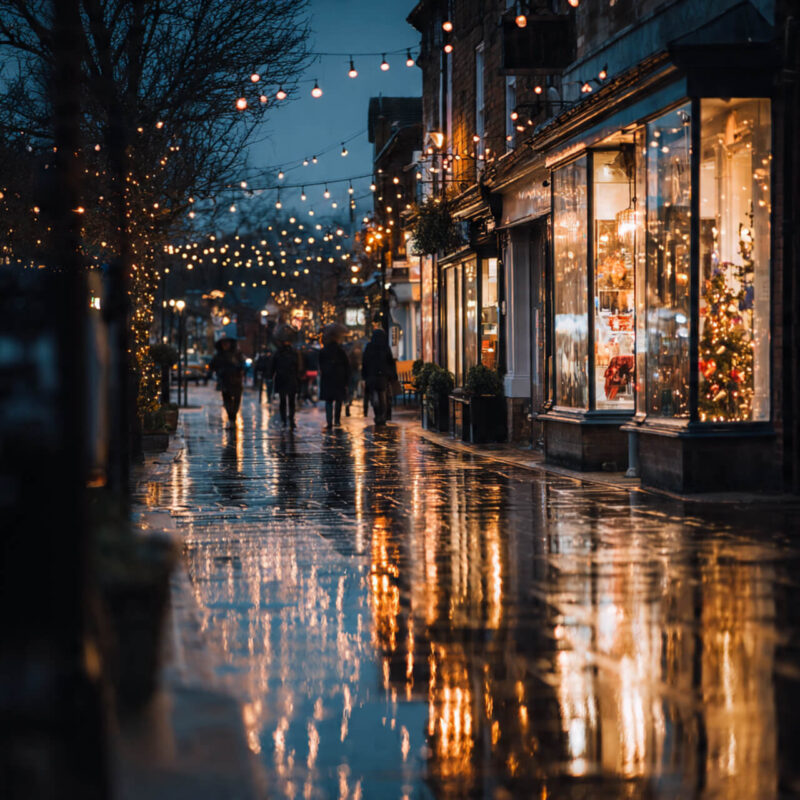
Finding Community in the Cold
Maybe you’re not into Halloween or Christmas. Fair enough—the commercial pressure around both can feel overwhelming.
But strip away the obligation and notice what’s actually happening: people making effort to connect when it would be easier to hibernate.
Kids running door to door on Halloween, laughter cutting through dark streets. Neighbors actually talking to each other about decorations. Strangers smiling at Christmas lights. The smell of cinnamon and pine. People gathering deliberately to create warmth in the coldest months.
You don’t have to go all out. You don’t need to be the house with the massive display. But small participation matters, one string of lights, handing out a few sweets, attending one community event.
Why? Because isolation makes seasonal mood drops worse. And these cultural moments are giving you permission and structure to connect, even when your instinct is to withdraw.
Your action step: Choose one small way to participate in seasonal community this year. Just one. Notice how it feels different from total withdrawal.
If you’re struggling to find momentum, you might like the Non-Negotiable Habit Tracker. It helps you keep small commitments that rebuild consistency, especially during the darker months.
What Does a Realistic Gratitude Practice for Winter Blues Look Like?
Let’s be clear about what we’re doing here. This is a natural way to cope with seasonal depression and winter mood drops—not a cure, but a practice. This approach to practical gratitude for winter blues is different from forced positivity. This isn’t:
- Pretending everything is wonderful when it isn’t
- Ignoring genuine mental health struggles
- Forcing positivity when you feel terrible
This is: Noticing what’s actually present, rather than only fixating on what’s missing.
The rain is still rain. The darkness is still dark. But alongside those truths, other truths exist:
- Rain makes our island green and alive
- Darkness creates space for intentional light and gathering
- Community often shows up strongest when we need it most
- There’s beauty in every season when you’re not spending all your energy wishing it was different
If you want a deeper dive into how small mindset shifts can support emotional health, read Overcome Depression Naturally — it explores simple, body-based changes that complement what you’re learning here.
Your Three-Part Practice for Winter Mental Health
1. Catch the resistance
When you notice yourself thinking “I hate this weather” or “I just need to get through this,” pause. That’s energy being spent on fighting unchangeable reality.
2. State the neutral fact
“It’s raining.” “It’s dark at 4pm.” “It’s November.” Just the fact, without the judgment or story.
3. Find one true thing that isn’t negative
Not forced positivity—just one genuinely neutral or positive observation. “The rain makes everything smell fresh.” “The streetlights look beautiful against the dark.” “I’m inside and warm.”
Do this once a day. That’s it. You’re not trying to revolutionize your entire mindset overnight, you’re practicing tiny redirects of attention.
According to a 2023 study in the Journal of Affective Disorders, even 15–30 minutes of outdoor light exposure per day can significantly improve mood during winter months.
(Source: ScienceDirect – Outdoor light exposure and mood regulation in winter)
For more on how to quiet perfectionism and show up imperfectly even in hard seasons, explore How to Overcome Perfectionism. It pairs perfectly with this mindset work.
Living in the Life You Actually Have
Here’s the uncomfortable truth: you could spend the next twenty years waiting for perfect conditions before you fully engage with life.
Perfect weather and the perfect season. Perfect mood and of course the perfect circumstances.
Or you could start now. In the rain. In the dark. On a grey Tuesday in November.
Because this is the life you actually have. Not the one you wish you had, not the one you’re waiting forthis one, right here, rain and all.
And there’s something quietly radical about choosing to be present for it.
Not in a “love every minute” way—some days will still be hard. Not in a “never struggle” way—SAD is real and sometimes you need support. But in a “I’m here, and I’m not waiting anymore” way.
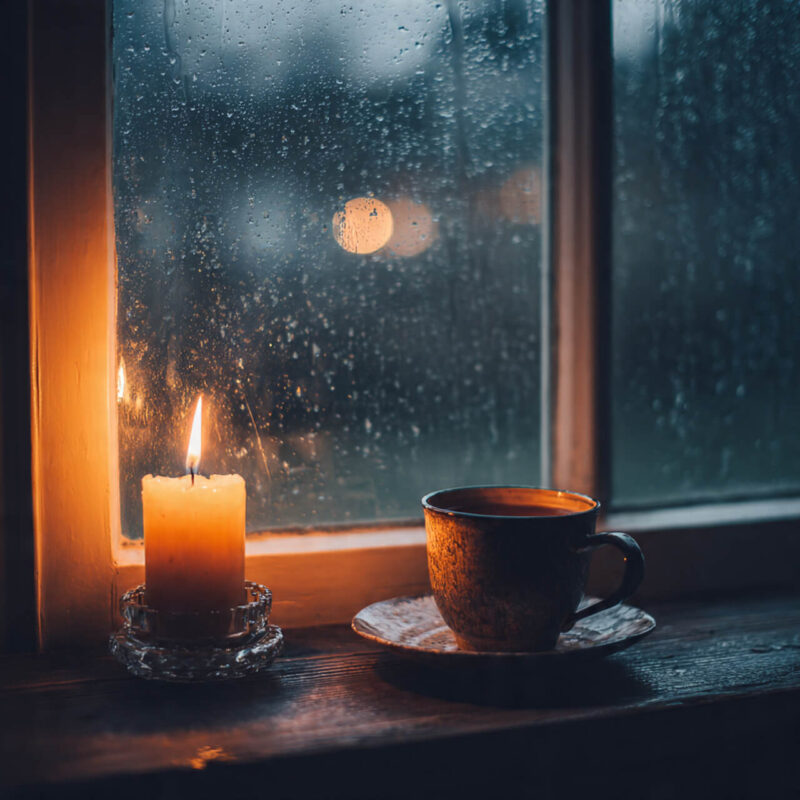
What to Do Right Now
Pick one:
If it’s raining: Put on a waterproof jacket and walk for 10 minutes. No destination, just notice.
If it’s dark: Light a candle or turn on one string of lights earlier than you normally would. Make your space intentionally cozy instead of just tolerating the gloom. Also, open your curtains fully during daylight hours and consider rearranging furniture to maximize natural light exposure—even grey daylight helps regulate your circadian rhythm.
If you’re feeling low energy: Get outside during daylight hours, even for 10 minutes. Movement helps—even gentle stretching or a short walk. Consider vitamin D3 supplements (speak to your GP about appropriate dosage for winter months). These physical foundations support your mental resilience.
If you’re feeling isolated: Commit to one small seasonal activity—attend one bonfire night, hand out Halloween candy, meet a friend for a winter walk. Just one.
If you’re struggling: Book an appointment with your GP. Check whether you’d benefit from a light therapy lamp or vitamin D supplements. Reach out to someone you trust. If symptoms persist for more than two weeks or interfere with daily life, please contact your GP or call the Samaritans on 116 123 (free, 24/7). This isn’t weakness—it’s wisdom.
The darkness will lift eventually. Spring will come. It always does.
But you don’t have to spend the next five months in a holding pattern, white-knuckling your way through until “real life” can resume.
You can live now. In this. Fully.
Even in the rain.
Everyday Mastery Steps You Can Take Now
Even small actions can help you feel more grounded through the darker months. Try these three gentle steps — no pressure, just presence.
- Shift your self-talk: When you catch yourself thinking “I can’t stand this weather,” reframe it to “This is the season I’m learning to live in.”
- Reclaim small rituals: Light a candle while making your morning cuppa, or play soft music while you cook dinner. Tiny sensory anchors help restore calm.
- Keep perspective: Remind yourself that the darkness is temporary — and you’re learning how to stay steady through change.

Mr Critic Moment:
“You really think a ten-minute walk in the rain is going to fix seasonal depression”
That voice sounds logical — but it’s wrong. Small, consistent actions train your brain to notice what’s still working. You’re not trying to “fix” winter; you’re proving that you can still show up for life inside it.
Not everyone hears an inner critic as a voice, some feel it as tension, hesitation, or withdrawal instead. However it shows up, noticing it is the first step toward loosening its grip.
3 Actions You Can Take Today
- Go for one 10-minute walk in the rain — no goal, just notice.
- Light a candle or string lights before sunset to create warmth on purpose.
- Text one friend to plan a winter walk or coffee this week.

Journaling Prompts:
What parts of winter do I usually resist — and what might I notice instead?
When do I feel most connected or alive during darker months?
What’s one tiny ritual I could add this week to bring light or warmth into my day?
Frequently Asked Questions About Winter Blues
How can I stop dreading winter in the UK?
Start by accepting that rain and darkness are unavoidable parts of living here, then redirect the energy you’re spending on resistance. Take one 10-minute intentional walk in the rain, open your curtains fully during daylight hours, and choose one small way to participate in seasonal community activities. These small shifts help you move from enduring winter to actually living during it.
Does gratitude actually help with seasonal depression?
Gratitude practices can help manage mild to moderate winter blues by shifting attention from what’s missing to what’s present, but they’re not a cure for clinical Seasonal Affective Disorder. If you’re experiencing genuine SAD symptoms—persistent low mood, changes in sleep or appetite, difficulty functioning—please speak to your GP. Gratitude works best alongside other supports like light therapy, vitamin D, professional care, and social connection.
When should I see a doctor about winter blues?
See your GP if symptoms persist for more than two weeks, interfere with your daily life or work, or if you’re experiencing significant changes in sleep, appetite, or energy. Don’t wait if you’re having thoughts of self-harm—call the Samaritans on 116 123 (free, 24/7) or contact your GP urgently. Early intervention makes a real difference, and seeking help is a sign of wisdom, not weakness.
What’s the difference between winter blues and Seasonal Affective Disorder?
Winter blues are mild mood dips that many people experience during darker months—feeling a bit low, less motivated, or more tired. Seasonal Affective Disorder (SAD) is a clinical form of depression with more severe, persistent symptoms that significantly impact daily functioning. SAD affects around 1 in 3 people in the UK to some degree and often requires professional treatment like light therapy, talking therapy, or medication. If you’re unsure, speak to your GP.
Can walking in the rain really improve my mood?
Yes, but not because rain is magically mood-boosting. Walking in the rain shifts you from passive resistance (spending energy being annoyed) to active engagement (noticing what’s actually happening). Physical movement releases endorphins, being outdoors helps regulate your circadian rhythm even on grey days, and the practice of noticing without judgment builds resilience. It’s less about the rain itself and more about choosing to participate in your life rather than waiting for perfect conditions.
For more inspiration, explore The Benefits of Walking — it’s proof that even the smallest steps can change your mood and your mindset.
What’s one small shift you could make this week to stop resisting and start living in this season? Share in the comments—I’d love to hear what you’re trying.
This is your permission slip to start messy.
We don’t chase perfect here — we practise progress, because that’s Everyday Mastery.
If you enjoy these posts and want to support the writing, you can buy me a coffee — it keeps the kettle (and the ideas) warm.
👉 Join the newsletter here to get new posts and reflection guides straight to your inbox.
Kel is the writer behind Everyday Mastery, where she shares the real, messy, and meaningful process of building habits, resilience, and self-belief from the ground up. Her writing blends ancient philosophy with modern science, always focused on small, practical steps that lead to lasting
